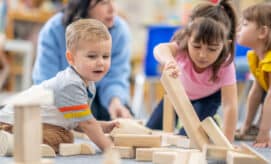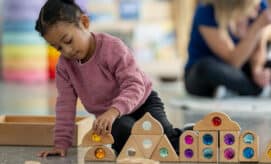At its core, child-led play is exactly what it sounds like: it’s play that is initiated and directed by the child, using materials they choose, and rules that they make up. In an article for the blog Imagination Playground, Andie Stallman, MA, a researcher in child studies and play, offers this description of child-directed play: “Child-directed play is led primarily by children and consists of activities they have chosen to participate in based on their interests and desires. This may look like independent block play or playing house with friends. Still, it does not include activities a teacher or parent has guided them toward or created rules for.”
How does Child-led Play Benefit Young Children?
When children choose and direct their own play, they are free to follow their curiosity, engage in activities that interest them, and try out new skills. A Seattle Children’s Hospital article created for parents of young children lists several ways in which child-led play can support young children’s learning and development:
- Builds a sense of self-direction and self-confidence. When children are given the opportunity to lead the way in their playful learning, it helps them to feel empowered, capable of trying new things in a fun and engaging way.
- Fosters language and social development. Child-directed play lets children engage in topics, ideas, and activities that interest them. As they play, they are likely to become eager to share their enthusiasm for the things they are working on, leading to meaningful, joyful conversations with peers and caregivers.
- Strengthens the caregiver-child relationship. When we follow a child’s lead during play, we are demonstrating our interest in the child’s ideas and the things that excite them. These interactions become meaningful moments that can help to strengthen our connection with each child.
How can I Incorporate Child-led Play into my Classroom?
Offer Open-Ended Materials
Check your classroom play spaces to ensure that they include a variety of open-ended materials for the children to engage with. These might include items found in nature like twigs and pinecones, or recycled materials, such as corks, mason jar rings, and pieces of wood. Because these items have no defined use or intended outcome, children are free to incorporate them into play in any way their imagination suggests.
Engage Individual Interests
Take time throughout the day to observe the children in your care as they play. Notice the kinds of materials, concepts, and ideas that they find interesting so that you can incorporate them into your classroom and curriculum. For example, if a child finds it particularly engaging to roll balls around the room, you might consider introducing other items that roll, such as pretend cars or different kinds of hoops. Or, if children are interested in building with wooden blocks, add in other items that can be used as building materials, such as cardboard boxes of different sizes. Offering items that incorporate and expand upon a child’s natural interests is a simple way to engage children in meaningful play and learning.
Schedule Time for Free Play
Try to schedule blocks of time throughout the day when children are invited to roam around your play space and be inspired by the items they find there. Keeping a variety of materials at the children’s eye level makes it more likely that an item will be discovered and be turned into a game or idea for play.
When you take a step back and observe during free play time, rather than initiating activities for the children, you offer children a chance to really take ownership of their play.
Say Yes!
Throughout the day, children will often ask if they can play with certain toys, read a specific book, or spend time outside. As often as possible, try to say yes! This is a simple way to follow the lead of the children in your care.






